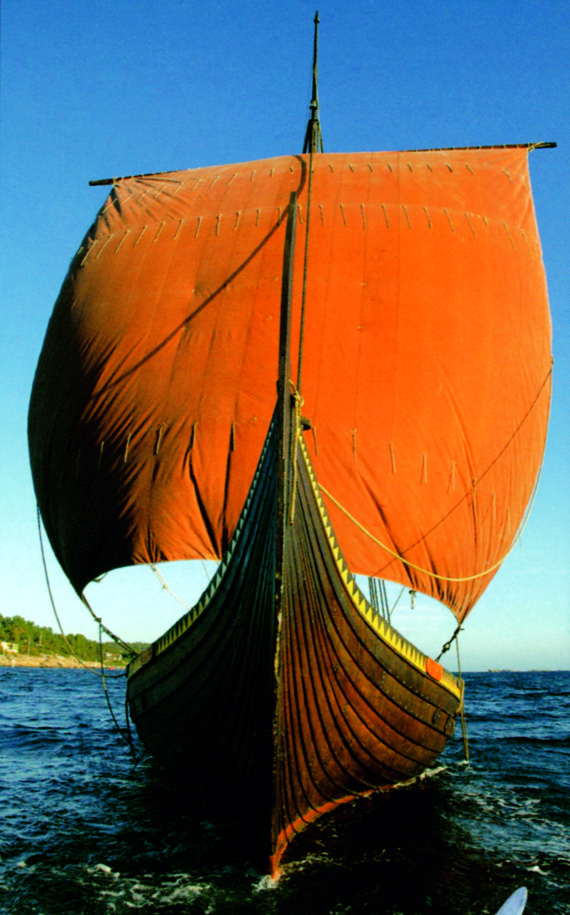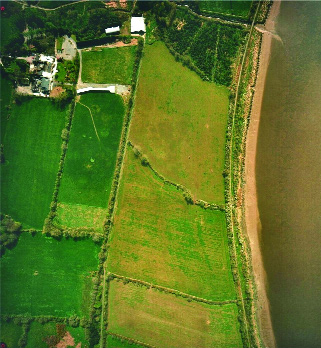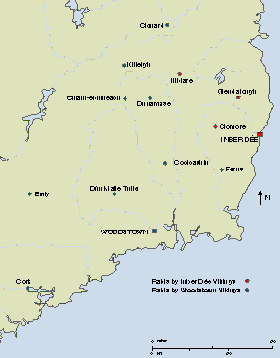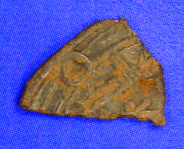Woodstown in the Irish annals
Published in Features, Issue 5 (Sep/Oct 2006), Medieval History (pre-1500), Volume 14

The replica Viking ship Gaia, which visited Dublin in July 2005. The large quantities of iron nails found at Woodstown indicate that people there were involved in repairing ships such as this. (Vestfold Fylkeskommune)
Very few Viking sites outside the major towns have ever been discovered in Ireland, and none outside Dublin has been excavated since the 1940s. And yet historical records such as the Irish annals describe many occupied Viking sites in the ninth- and tenth-century Irish countryside, often referring to them as longphorts.
Longphorts and rural Viking settlement
The term longphort was used by medieval Irish chroniclers to refer to many different types of sites; even early Dublin was called a longphort. The term literally translates as ‘ship camp’, and the most traditional definition of a longphort by historians would be a temporary base used primarily for raiding. This definition, though, is probably overly simplistic, and the ninth- and tenth-century Irish writers do not seem to have used the term as diagnostically as modern scholars would like. For example, in 866
‘Áed, son of Niall, plundered all the strongholds (longphorts) of the foreigners, i.e. in the territory of the North, both in Cenél Eógain and Dál Araidi, and took away their heads, their flocks, and their herds from camp by battle. A victory was gained over them at Loch Foyle and twelve score heads taken thereby’.
If the inhabitants of these sites had flocks and herds, they were planning to stay, or already had stayed, for a while. Prior to the raid on these Viking sites neither is ever mentioned, suggesting that the ‘foreigners’ who lived there may never have carried out a raid. So if these sites could be called longphorts by Irish writers, then the old definition of a raiding base must be only part of the overall picture of Viking settlement in Ireland.
That said, the definition of a temporary raiding base can certainly be fairly applied to some Viking sites, and Woodstown would seem to fit that description. The archaeological remains, especially the large quantities of iron nails, indicate that the people at the site were involved in repairing ships. Ships were of course necessary for Viking raids, and part of the reason for their success. Weights for a balance scale were also found on the site, and these could well have been used by raiders to divide up their plunder amongst themselves. The broken remains of ecclesiastical objects, like those found at Woodstown, are just the sort of loot we would expect to find at raiding bases used by Vikings to attack Irish churches and monasteries. The possible burial of a high-status Viking warrior on the site (there was no body, but the partial remains of a shield and a sword were among the artefacts) also points to its use as a raiding base. Over the years, and unrelated to the new excavations, silver hoards have been found in the area.

Aerial view of Woodstown in 2001. (Waterford County Council)
Hoards that do not contain coins cannot be dated very accurately, but these silver-only hoards were mostly deposited before 950 or so, when the use of coinage became more widespread. Some of these hoards could well be related to the Woodstown site, although it must be acknowledged that most probably were not.
So far, no firm date for the foundation of the Woodstown site has been established, nor do we know how long the site remained occupied. But in general the radiocarbon dates do not preclude an early ninth-century date for the site. The Arabic coin fragments found during excavations are the only artefacts that may be able to provide closer dates, but they have yet to be analysed. Further, based on the limited excavations conducted thus far, the stratigraphy—the depth of excavated occupation—suggests that the site was occupied and used only temporarily; for example, there is no indication from the preliminary excavation reports that structures were rebuilt, while homes at Viking Dublin had to be rebuilt every fifteen to twenty years owing to Ireland’s wet climate.
Written sources
We might expect that a well-organised, successful Viking raiding base would be mentioned in contemporary sources, such as the various sets of Irish annals. Of the sets of Irish annals that were being written during the first half of the ninth century, the Annals of Ulster and the Chronicum Scottorum contain the most complete records for south-eastern Ireland. The much later, seventeenth-century compilation, The Annals of the Kingdom of Ireland by the Four Masters, more commonly known as the Annals of the Four Masters, can also be an invaluable resource. Although it is not a contemporary source, like the Annals of Ulster and the Chronicum Scottorum, the ‘Four Masters’ clearly relied on sources that we still have today, like the two already mentioned.

Viking raids ( Sarah Gearty)
The writers of the Annals of the Four Masters also appear to have had access to chronicles that are now lost to us, and that information can supplement what we know from contemporary chroniclers. But the Annals of the Four Masters must be used with caution. To give one example, for the year 834 (referred to as 833) the Annals of the Four Masters record ‘The plundering of Glendalough, Slane, and Fennor, by the foreigners’. Slane and Fennor are near each other and accessible by the same waterways, but Glendalough is considerably further south, and was probably not raided by the same group of Vikings as those who attacked Slane and Fennor. The earlier annals do in fact make the distinction between the raiding events far more clearly than do the writers of the Annals of the Four Masters. So we can learn from all available written sources, but each must be treated with appropriate caution.
Inber Dée
Although no Viking longphort at or near the Woodstown site is specifically named in any of the sets of Irish annals, there is evidence from those sources that may actually describe the activities of its inhabitants, including something of where they were encamped just before moving to the Woodstown site. There were a number of raids in and around the rivers of south-eastern Ireland clustering between the years 832 and 848. The chroniclers of the period tell us that the raids were carried out by ‘foreigners’, and only once, for the year 836, do the authors of the Annals of Ulster and the Chronicum Scottorum name a Viking habitation site: Inber Dée. Raids from the first few years of the cluster, between 834 and 836, most likely relate to Vikings who were staying at this place called Inber Dée, somewhere in County Wicklow. The place-name has not survived into the modern period, but Inber Dée was probably located somewhere near Arklow, itself a Scandinavian place-name. The monasteries raided between 834 and 846 include Glendalough, Ferns and Clonmore, all more easily accessed from the east, i.e. County Wicklow, than from the west, County Waterford (and potentially Woodstown). In 836 Irish chroniclers state that Vikings from Inber Dée attacked Kildare. According to the Chronicum Scottorum, that same year Clonmore was attacked again, this time on Christmas night. This clearly demonstrates that the group of Vikings who carried out the raid were overwintering somewhere nearby, and Inber Dée of the annals is the most likely candidate.
Woodstown?
The later series of raids from the cluster mentioned above, carried out nearly annually between 839 and 848, are more likely to have been conducted by the inhabitants of Woodstown. These raids began almost immediately after the raids around Inber Dée ended, and it is quite possible that the group from Inber Dée relocated in 837 or 838. After a two-year hiatus in raids in south-east Ireland, in 839 ‘Ferns and Cork were burned by the heathens’. If the Inber Dée Vikings did indeed move to a new location, further inland and yet with access to three major waterways, it would help to explain why these sites were the first to be raided. The Vikings of Inber Dée were already familiar with Ferns, since it was probably they who raided that monastery in 835. Woodstown is centrally located between Ferns and Cork, with access to both along the south coast. It would have made sense for the Vikings to attack a site they already knew when starting afresh in a new home, since they knew what to expect and were thus more likely to succeed in their raid. Cork was well known and again easily accessed by sailing along the southern coast of Ireland. Raiding at a safe distance from their home base meant that, at least for that year, the Vikings of Woodstown might have been able to maintain good relations with their Irish neighbours. At the least, choosing not to raid too close to home may have helped to hide their presence at the site.
After 839 the Vikings raided inland rather than along the coast, mainly along the rivers Suir, Nore and Barrow, all easily accessed from Woodstown. Monasteries, churches and the royal site of Dunamase were all plundered, and one abbot was taken alive. He may have been held for ransom or sold into slavery along with other captives. The chroniclers report that Vikings killed other churchmen and carried out more raids in the area over the next several years.
In 848 this cluster of raids ended suddenly and rather ominously for the Vikings. According to the Annals of Ulster and the Chronicum Scottorum, ‘The Eóganacht of Cashel inflicted a rout on the heathens at Dún Maíle Tuile, in which five hundred fell’. The exact location of this battle remains something of a mystery. In the well-known Onomasticon Goedelicum, first published in 1910, Edmund Hogan suggested simply that Dún Maíle Tuile was located ‘near Cashel’, perhaps in County Tipperary or County Waterford. The entry quoted above was clearly the basis for Hogan’s placement. Kevin Murray of the Locus place-names project at University College Cork suggested to me that eastern County Limerick, near or in the barony of Coshma, might have been the location of Dún Maíle Tuile.

Arabic coin fragments such as this found during excavations may accurately date the site once they are analysed. (ACS)
This is because the Corpus genealogiarum Hiberniae lists a ‘Máel Tuile mac Cúain’ of the Uí Meic Erce family from about the right period. In the early ninth century members of the Uí Meic Erce dynasty were rulers of the Uí Fidgente territory, itself a tributary kingdom of the Eóganacht of Cashel. So while County Limerick is a bit further from Woodstown than ‘near Cashel’, the connection of the Dún Maíle Tuile site with the neighboring Eóganacht dynasty is clear. The Eóganacht of Cashel fought these raiders at the stronghold of the leader of one of their tributary kingdoms. This event suggests that the Vikings who were defeated in 848 were based in Eóganacht territory. Once again, the recently discovered site at Woodstown would certainly fit the bill.
Chroniclers do not record any more raids by unidentified groups of Vikings in the vicinity of Woodstown until 866. The Eóganacht rout of the Vikings must have been successful enough to prevent other groups from attempting to settle in the area. Even the raid in 866 is something of an anomaly, and no follow-up raids were recorded. While other groups of Vikings whose home was named, including the Vikings from ninth-century Dublin, raided in the area, it was really not until the Viking town of Waterford was founded that south-eastern Ireland once again found itself under continuous attack by the Vikings.
Conclusions
While it is impossible to state categorically that the raids recorded between 832 and 848 were all related to the Vikings of Inber Dée and Woodstown, or even that the two groups were the same, the evidence is certainly suggestive. Between 832 and 836 Vikings from Inber Dée carried out a number of raids in and around what is today County Wicklow. They then disappear from the written historical records—unless they moved on and settled at Woodstown. Starting in 839, some group of Vikings, possibly those from Woodstown, raided every other year or so in southern and south-eastern Ireland. But in 848 a large number of the raiders were killed in battle with Irish forces. The fate of the remaining inhabitants remains unknown. Archaeological evidence from Woodstown suggests that women were living at the site. If the Woodstown Vikings were those who were defeated at Dún Maíle Tuile, the women and other survivors may have been killed or taken as slaves by the victorious Irish. Conceivably, they could even have remained but behaved themselves, carrying out no more raids and perhaps trading peacefully with their Irish neighbours. If this were the case, then the Woodstown site could possibly be related to the later town at Waterford. But the medieval chroniclers never make any of these claims, so perhaps the survivors returned to Scandinavia, or were able to join another raiding Viking band elsewhere in Ireland.
If these early ninth-century raids were indeed carried out by the same Vikings who lived at the recently discovered archaeological site, Woodstown would clearly be the earliest Viking site yet discovered in Ireland. Further, it would be a truly Viking, rather than Hiberno-Scandinavian, site, and a genuine example of a traditionally defined longphort, a temporary Viking raiding base. And if the habitation site for the Vikings responsible for these early ninth-century raids proves to be somewhere other than Woodstown, then there is another site—equally well preserved, we hope—waiting to be discovered. There is much that further excavations at the Woodstown site could tell us about the beginnings of a Scandinavian presence in Ireland, and we can only hope that the site will be protected until it can be fully excavated.
Mary A. Valante is an associate professor of history at Appalachian State University.
Further reading:
E. Bhreathnach, ‘Saint Patrick, Vikings and Inber Dée longphort in the early Irish literary tradition’, in C. Corlett and A. O’Sullivan,Wicklow Archaeology and History 1(1998).
C. Etchingham, ‘Evidence of Scandinavian settlement in Wicklow’, in K. Hannigan and W. Nolan (eds), Wicklow: history and society (Dublin, 1994).
D. Ó Corráin, Ireland before the Normans (Dublin, 1972).
J. O’Sullivan and Michael Stanley (eds), Recent archaeological discoveries on National Road Schemes 2004: proceedings of a seminar for the public, Dublin, September 2004 (Dublin, 2005).
















